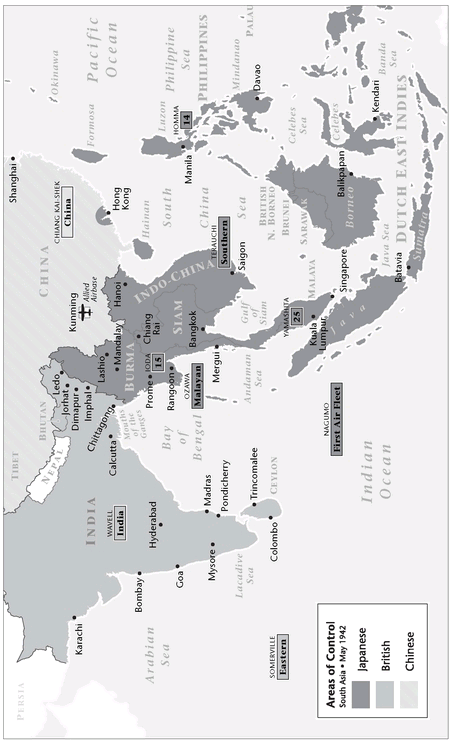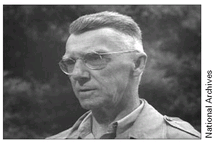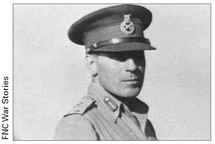War Stories II (29 page)
Authors: Oliver L. North

Thanks to the skill and daring of the Flying Tigers, Kunming didn't fallâand the Chinese stayed in the war, effectively tying up more than twenty-five Japanese divisions that wouldn't be used elsewhere against the Americans. And Claire Chennault, the man who had gone to China as a retired Army Air Corps captain in 1937, returned to the United States in 1945 as a major general.

CHAPTER 8
THE FORGOTTEN FRONT
CHINA-BURMA-INDIA THEATER (1937â1945)
 BRITISH BASE AREA
BRITISH BASE AREALALAGHAT, INDIA
JUNE 1943
JUNE 1943
T
he decision to dissolve Claire Chennault's American Volunteer Group and reconstitute it as a regular U.S. Army Air Corps unit wasn't the result of petty jealousies or a “power grab” by the 14th Air Force, as some claimed at the time. Rather, it was the consequence of a major reorganization in the Allied war effort that British prime minister Winston Churchill had been advocating since shortly after Pearl Harbor.
he decision to dissolve Claire Chennault's American Volunteer Group and reconstitute it as a regular U.S. Army Air Corps unit wasn't the result of petty jealousies or a “power grab” by the 14th Air Force, as some claimed at the time. Rather, it was the consequence of a major reorganization in the Allied war effort that British prime minister Winston Churchill had been advocating since shortly after Pearl Harbor.
With England struggling against Hitler in Europe and Africa, the warlords in Tokyo decided that the time was right to “liberate the Asian people” in Burma. Churchill had initially believed that Britain could defend her empire alone, but he soon realized that American help would be essential if the crown were to hold on to its most prized possession in the Far East: India.
By April 1942, the U.S.-British Joint General Staff had hammered out a compromise command arrangement for what they called the
China-Burma-India theater. The British would have overall command and the mantle was given to Field Marshal Harold Alexander. General William Slim was the British ground forces commander, and his American counterpart, “Vinegar Joe” Stilwell, Chiang Kai-shek's senior American advisor, was designated the chief U.S. officer in the region. Even though Stilwell had his headquarters with Chiang Kai-shek in China, both British and U.S. combat forces were intended to operate independently, relying on the combined staff in India for coordination and support.
China-Burma-India theater. The British would have overall command and the mantle was given to Field Marshal Harold Alexander. General William Slim was the British ground forces commander, and his American counterpart, “Vinegar Joe” Stilwell, Chiang Kai-shek's senior American advisor, was designated the chief U.S. officer in the region. Even though Stilwell had his headquarters with Chiang Kai-shek in China, both British and U.S. combat forces were intended to operate independently, relying on the combined staff in India for coordination and support.
Though the command-and-control arrangement was less than ideal, it was far from the greatest challenge the new CBI commanders faced. They were all aware that Churchill and Roosevelt had decided that the European campaign was to have first priority for all ships, planes, tanks, troops, and war-fighting matériel. Stilwell also knew that MacArthur, smarting in Australia and anxious to avenge his humiliating withdrawal from the Philippines, would receive the second-highest allocation of those scarce resources. These realities meant that a constant shortage of men and matériel would characterize the entire Allied campaign in the CBI theater.
The new command measures had little effect on the Imperial Army's relentless advance into Burma. The Japanese 15th Army, commanded by General Shojiro Iida, had four well-supplied, combat-hardened divisions, the 18th, 33rd, 55th, and 56th, supported by more than 400 aircraft. The demoralized British colonial troops and the two understrength Chinese divisions led by Stilwell lacked almost everything and had virtually no air support other than Chennault's AVG.
Â
General Joseph Stilwell

By 21 April, as the Japanese were preparing for their final offensive in the Philippines, the outnumbered and outgunned British forces in Burma were in full retreat, hacking their way 600 miles through mountainous jungle back into India. Stilwell's Chinese troops commenced a retreat of their own, fighting their way back into China, arriving emaciated and exhausted after more than a month in the jungle.
By mid-May 1942, the Japanese held all of Burma, were on the attack against Chiang in China, and were threatening India. From this point onward, the Allies' shortages of conventional combat forces and extraordinary logistics challenges would dictate their strategy and tactics in the region. Their paucity of combat power made it necessary for both the British and the Americans to employ highly irregular warfare techniques and made the CBI theater the venue for some of the most spectacular unconventional operations of World War II.
By their very nature, unconventional operations require leaders with imagination who can “think outside the box” and motivate those they lead to undertake daring action deep in enemy territory against numerically superior adversaries. The British had such a man in Major General Orde C. Wingate. For the Americans it was Major Frank Merrill on the ground and Claire Chennault in the air. The forces that these three men commanded were outnumbered 700 to 1 by the Japanese. Yet between spring 1942 and late 1944, these three leaders and the men they commanded succeeded in inflicting enough damage on the Japanese 15th Army in Burma that it were unable to exploit its initial advantage and launch successful offensives against India to the west or northward against Chiang.

Major General Orde C. Wingate was a maverick in every sense of the word. He had been serving in Palestine when the War Office assigned him to the British campaign to liberate Ethiopia from Mussolini's Italian Occupation Army in early 1941. Wingate organized a unit of irregulars mounted on horses and camels that he called the Gideon Force. Though his troops made only a modest contribution to the success of the five-month fight, on 5 May Wingate was accorded the honor of riding beside Haile Selassie, the “Lion of Judah,” when the Ethiopian emperor made his triumphal entry into Addis Ababa.
The positive press coverage of Wingate's Ethiopian escapade convinced Churchill's senior officers to overlook the man's considerable eccentricities and grant his wish to try his Long-Range Penetration (LRP) concepts
against the Japanese in Burma. As soon as he arrived in India, Wingate set about recruiting a force of more than 2,500 Burmese and Indian troops led by British officers and NCOs to start operating deep inside Burma. He called them Chinditsâand worked them mercilessly, marching them up and down the mountains and teaching them to fight in the jungle and live off the land with minimal supplies.
against the Japanese in Burma. As soon as he arrived in India, Wingate set about recruiting a force of more than 2,500 Burmese and Indian troops led by British officers and NCOs to start operating deep inside Burma. He called them Chinditsâand worked them mercilessly, marching them up and down the mountains and teaching them to fight in the jungle and live off the land with minimal supplies.
Â
Major General Orde Wingate led Britain's Special Forces in Burma.

By February 1943, Wingate believed his men were ready. British HQ gave the green light for 2,800 Chindits to launch an LRP attack into the trackless mountains along the IndoâBurmese border frontier. In a break with traditional warfare doctrine, Wingate sent RAF officers with each of his units to help maintain contact with British aircraft that would parachute supplies to his troops.
For four months, the Chindits, operating hundreds of miles deep inside Burma, cut Japanese communications and supply lines, destroyed railroads, and thoroughly disrupted General Iida's plans for an attack into India. By the end of April, with the weather deteriorating and his outnumbered, exhausted men suffering from malaria and prolonged exposure in the mountainous jungle, Wingate decided to break contact and hastily withdraw to India before they were surrounded by the Japanese. Though they were closely pursued by the Imperial 15th Army, the withdrawal of the Chindits proceeded in relatively good order, unlike the British rout less than a year before.
When Wingate's men arrived back in India in June 1943, the LRP operation was deemed to have been a great successâthough it had come at the cost of more than 800 British and colonial soldiers killed or missing. But during the course of their hurried withdrawal, Wingate had been compelled to make some agonizing decisions. Lacking any means of evacuating his wounded, he had no choice but to leave them behind rather than slow his entire column and put them all at risk of death or capture.
On several occasions, rather than sacrifice 2,000 still able-bodied men, Wingate gave the sick and wounded extra ammunition, some grenades,
water, and a Bibleâand left them beside the trail as the others marched away. Often, before the departing troops were out of earshot, they heard the explosions or gunshots from the place where they had left wounded comrades who had chosen not to wait for the Japanese troops to arrive and use them for bayonet practice. Distraught over the inability to evacuate his casualties, Wingate spent the balance of 1943 training replacements, refitting and repairing his battered LRP force, and trying to solve the demoralizing medical evacuation problem.
water, and a Bibleâand left them beside the trail as the others marched away. Often, before the departing troops were out of earshot, they heard the explosions or gunshots from the place where they had left wounded comrades who had chosen not to wait for the Japanese troops to arrive and use them for bayonet practice. Distraught over the inability to evacuate his casualties, Wingate spent the balance of 1943 training replacements, refitting and repairing his battered LRP force, and trying to solve the demoralizing medical evacuation problem.
Wingate wasn't the only one using the interval to rebuild in India. Stilwell was also utilizing bases along the Indian plain to train Chinese troops. U.S. Army engineers were busy trying to reopen the Burma Road so that Chiang's forces would no longer have to rely solely on American pilots flying over the Himalayas for resupply. By the winter of 1943â44, with Admiral Louis Mountbatten now in command of the Allied effort in the CBI theater, the British in India and the Americans in China were finally preparing to go on the offensive.
Unfortunately, so were the Japanese. Having consolidated its positions and established puppet regimes in Indochina, Malaya, and the Philippines, Tokyo ordered the commander in Burma, General Renya Mutaguchi, to launch a fresh offensive against India.
The Japanese set a start date of 17 April 1944 for the campaign, code-named Operation Ichi-Go, to commence. British code-breakers intercepted the message, and Mountbatten decided to disrupt Mutaguchi's plans by sending two LRP columns into Burma. Wingate's Chindits were to enter from the west and Merrill's Marauders from the north. For the first time in the CBI theater, gliders and paratroopers would be used to insert forces deep behind enemy lines and Claire Chennault's Flying Tigersânow part of the 14th Air Force and equipped with more than 300 bombers, transports, and fightersâwould support the British with “air commando” operations.
Other books
Debutantes by Cora Harrison
Sunday Best by Bernice Rubens
Imperfectly Bad by A. E. Woodward
The Merchant of Menace by Jill Churchill
The Warrior (The Rebellion) by Jordan Magera
La Brat by Ashe Barker
Shelly's Second Chance (The Wish Granters, Book One) by Gschwandtner, L B
Brechalon by Wesley Allison
Walter & Me by Eddie Payton, Paul Brown, Craig Wiley
